Accepted Scientific Name: Beaucarnea recurvata Lem.
Ill. Hort. Misc.: 59 1861.
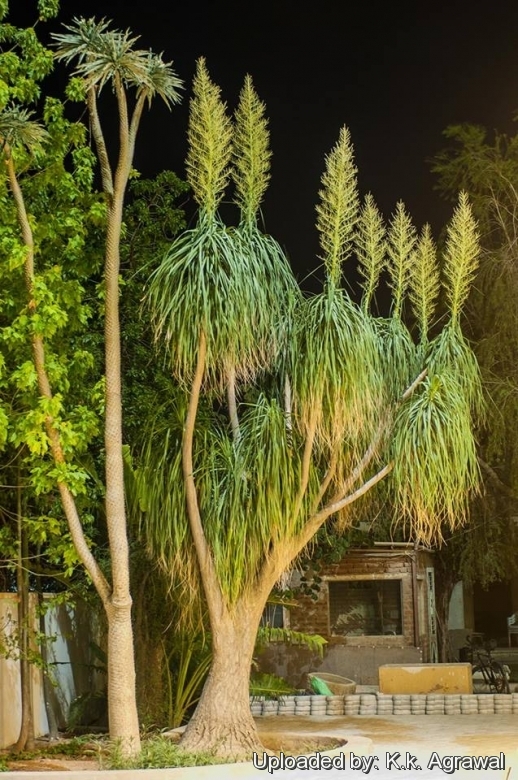
Nolina recurvata (Beaucarnea recurvata) Photo by: K.k. Agrawal
Big Nolina flowered after 20 years. On the left is Pachypodium lamerei.
Synonyms:
See all synonyms of Beaucarnea recurvata
back
Accepted name in llifle Database:Beaucarnea recurvata Lem.Ill. Hort. Misc.: 59 1861.Synonymy: 9
back
Common Names include:
ENGLISH: Ponytail Palm, Bottle ponytail, Beaucarnea, Pony tail palm, Elephant's foot, Pony Tail, Elephant Foot Tree, Bottle Palm
CHINESE (中文): 酒瓶蘭
ESTONIAN (Eesti): Käändbokarna, Bokarna
FINNISH (Suomi): Pullojukka
FRENCH (Français): Arbre bouteille
GERMAN (Deutsch): Elefantenfuß
ITALIAN (Italiano): Nolina, Pianta Mangiafumo, Mangiafumo
JAPANESE (日本語): トックリラン
POLISH ( Polski): Noga słonia, Stopa słonia, Beukarnea wygięta, Nolina wygięta
RUSSIAN (Русский): Бокарнея отогнутая, нолина отогнутая
SPANISH (Español): Pata de Elefante, Biucarnea, Nolina, Bocarnea, Soyate Pata de Elefante, Soyate de Tehuantepec, Palma Culona, Monja
SWEDISH (Svenska): Flasklilja
Description: Also known as the “Pony Tail Palm” or “Bottle Palm” (though it is not a true palm) Beaucarnea recurvata was introduced into cultivation from Mexico about 1845. It is a dioecious, evergreen, succulent tree up to 9 m tall (but rarely more than 1,20 to 2,50 indoors) with a very noticeable swollen base that tapers up to a slender trunk that ends in a head of green and recurving foliage. It is a slow-growing very peculiar species often seen as a houseplant, that people either love or hate.
Stem: Juvenile plants are single-stemmed with a bulbous base that start thickening at an early seedling stage, forming soon a neat, firm, rounded caudex and the small plants are pulled underground by contractile roots. Mature specimens produces a stout caudex up to 3,60(-4) meters in diameter, most of which is above ground, with one or more branched trunks. The caudex can store water up to 1 year.
Leaves: Strap-like, grass-like, thin, flat narrow, dark green, 90-200 cm long and 1-2,5 cm wide that form clumps at the ends of the branches and droop down. The cascading nature of the leaves gives much the appearance of a pony’s tail (hence the common name).
Inflorescence: Large, pyramidal shaped panicles 75-110 cm tall at the branch tips.
Flower: Greenish-white to yellowish-crème coloured with six tepals, but very small and inconspicuous individually (1.5 mm diameter), but on the whole quite showy in the clusters that extend above the leaves;
Blooming season: Flowers occasionally once plants mature (often when it's 20 years old or more) and then in late spring or summer for several weeks. The tree will occasionally flower two or even three times a year.
Fruit: reddish winged fruit with 2-3 seeds.
Remaks: Beaucarnea and Calibanus are closely related but distinct from Nolina and like Dasylirion, Beaucarnea has 3-winged 1 locular “nutlets.”
Subspecies, varieties, forms and cultivars of plants belonging to the Beaucarnea recurvata group
 Beaucarnea recurvata Lem.: is a dioecious succulent tree up to 9 m tall with a swollen base tappering up to a slender trunk that ends in a head of green and recurving foliage. Distribution: south-eastern Mexico.
Beaucarnea recurvata Lem.: is a dioecious succulent tree up to 9 m tall with a swollen base tappering up to a slender trunk that ends in a head of green and recurving foliage. Distribution: south-eastern Mexico. Beaucarnea recurvata f. variegata hort.: has dark green leaves margined with cream coloured edges.
Beaucarnea recurvata f. variegata hort.: has dark green leaves margined with cream coloured edges.
Bibliography: Major references and further lectures
1) Forest & Kim Starr “Beaucarnea recurvata (Pony tail palm, beaucarnea, bottle ponytail)”. Plants of Hawaii. <http://www.starrenvironmental.com>. Web. 27 December 2014
2) Wikipedia contributors. "Beaucarnea recurvata" Wikipedia, The Free Encyclopedia. Wikipedia, The Free Encyclopedia, 18 Dec. 2014. Web. 31 Dec. 2014.
3) Urs Eggli “Illustrated Handbook of Succulent Plants: Monocotyledons: Monocotyledons” Springer Science & Business Media, 17 July 2001
4) Irish, Gary "Agaves, Yuccas, and Related Plants: A Gardener's Guide." Timber Press. 2000
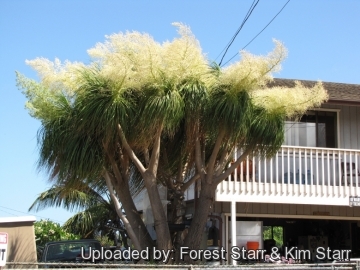 Flowering habit at Paia, Maui, Hawaii, USA. June 16, 2009. (Beaucarnea recurvata) Photo by: Forest Starr & Kim Starr
Flowering habit at Paia, Maui, Hawaii, USA. June 16, 2009. (Beaucarnea recurvata) Photo by: Forest Starr & Kim Starr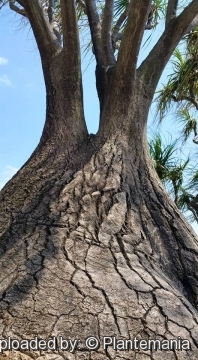 Nolina recurvata. Caudex at le jardin exotique de Monaco. (Beaucarnea recurvata) Photo by: © Plantemania
Nolina recurvata. Caudex at le jardin exotique de Monaco. (Beaucarnea recurvata) Photo by: © Plantemania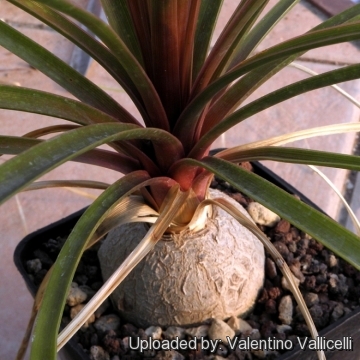 Nolina recurvata (Beaucarnea recurvata) Photo by: Valentino Vallicelli
Nolina recurvata (Beaucarnea recurvata) Photo by: Valentino Vallicelli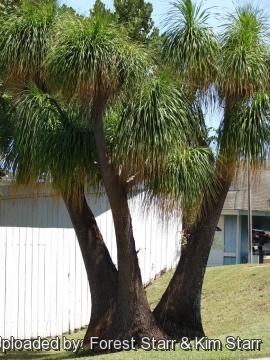 Habit at Paia, Maui, Hawaii, USA. April 29, 2009. (Beaucarnea recurvata) Photo by: Forest Starr & Kim Starr
Habit at Paia, Maui, Hawaii, USA. April 29, 2009. (Beaucarnea recurvata) Photo by: Forest Starr & Kim Starr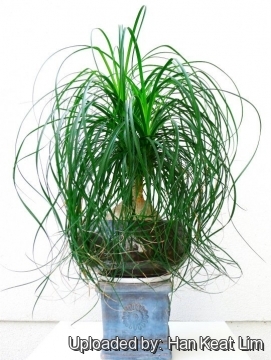 Nolina recurvata (Beaucarnea recurvata) Photo by: Han Keat Lim
Nolina recurvata (Beaucarnea recurvata) Photo by: Han Keat Lim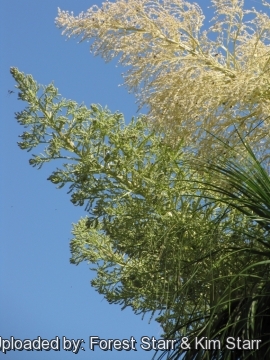 Flowers at Paia, Maui, Hawaii, USA. June 16, 2009. (Beaucarnea recurvata) Photo by: Forest Starr & Kim Starr
Flowers at Paia, Maui, Hawaii, USA. June 16, 2009. (Beaucarnea recurvata) Photo by: Forest Starr & Kim Starr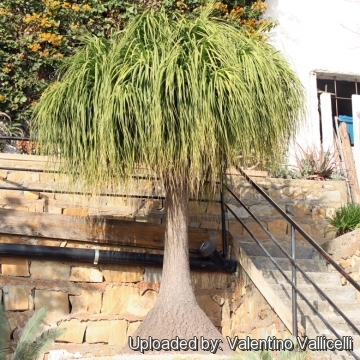 Nolina recurvata (Beaucarnea recurvata) Photo by: Valentino Vallicelli
Nolina recurvata (Beaucarnea recurvata) Photo by: Valentino Vallicelli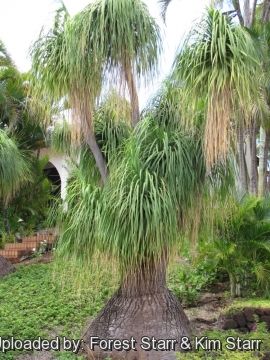 Habit at Lahaina, Maui, Hawaii, USA. July 13, 2009. (Beaucarnea recurvata) Photo by: Forest Starr & Kim Starr
Habit at Lahaina, Maui, Hawaii, USA. July 13, 2009. (Beaucarnea recurvata) Photo by: Forest Starr & Kim StarrCultivation and Propagation: Beaucarnea recurvataSN|20517]]SN|20517]] are related to False Palms (Yucca species) and need similar care, they are among the easiest “palms” to grow indoors as houseplants, and outdoor as ornamental plants in temperate climate gardens. The plants are very slow growing, so don't expect great growth spurts from year to year and very drought tolerant, give them lots of sun to light shade, well drained soil mix and water deeply but infrequently in summer and fertilize them only once during this period. During the winter months, the plants are watered only enough to keep the foliage from wilting. Over-watering is the most frequent cause of failure when growing Beaucarneas. They are pretty resistant to rotting if all other conditions are good. Indoors they are often grown in shallow pots, with a tuft of strappy green leaves emerging from a bulbous stem that seems to erupt from the soil. It is a plant for people who don't want a lot of work taking care of their plants, as it seems to thrive on neglect , and indoors are manageable in size if kept in a small pot but need a good amount of direct sunlight through the window. The plant is quite hardy and can even stand frost (-7 C).
Maintenance: Remove older leaves that start to become yellow or brown and cut off the spent flower stalk. Leaf tips have a tendency to dry and be brown in the house, so if possible place it outside in the summer.
Pest and disease: Bugs, mealy bugs and mites usually are not a problem with the Beaucarnea, however if they do appear, simply spray the houseplant down with a soapy water mix twice a day until they are gone.
Propagation: Cuttings and seeds. Seed is sown in the spring and will germinate at about 20° C.
Use: It is often used as specimen container plant, near patios, or placed in rock gardens for its irregular outline or silhouette, it is also suitable for growing indoors.
Your Photos
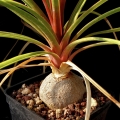
by Valentino Vallicelli

by Josef Cycad Perner

by Cactus Art
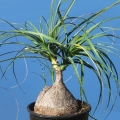
by Valentino Vallicelli
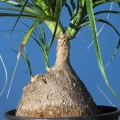
by Valentino Vallicelli






















